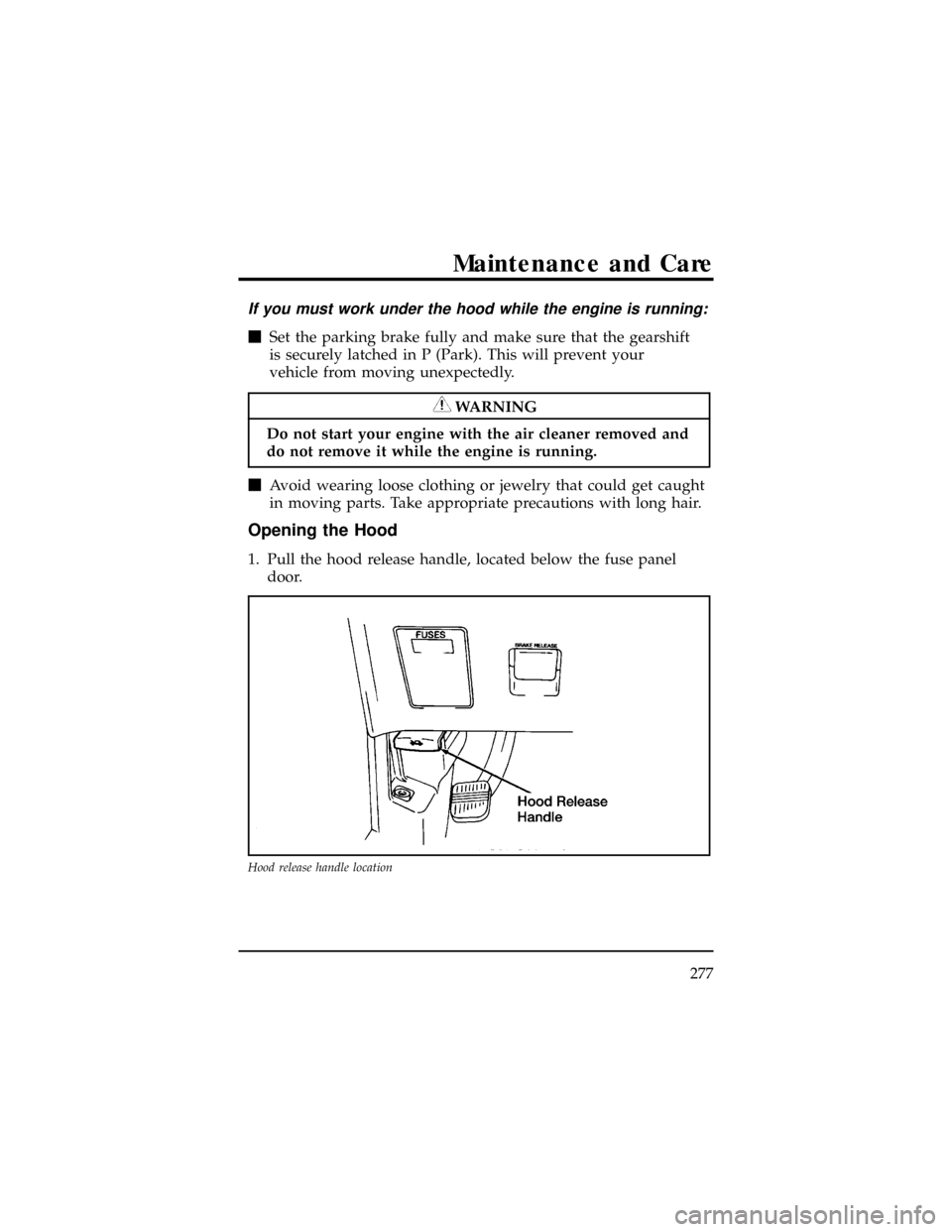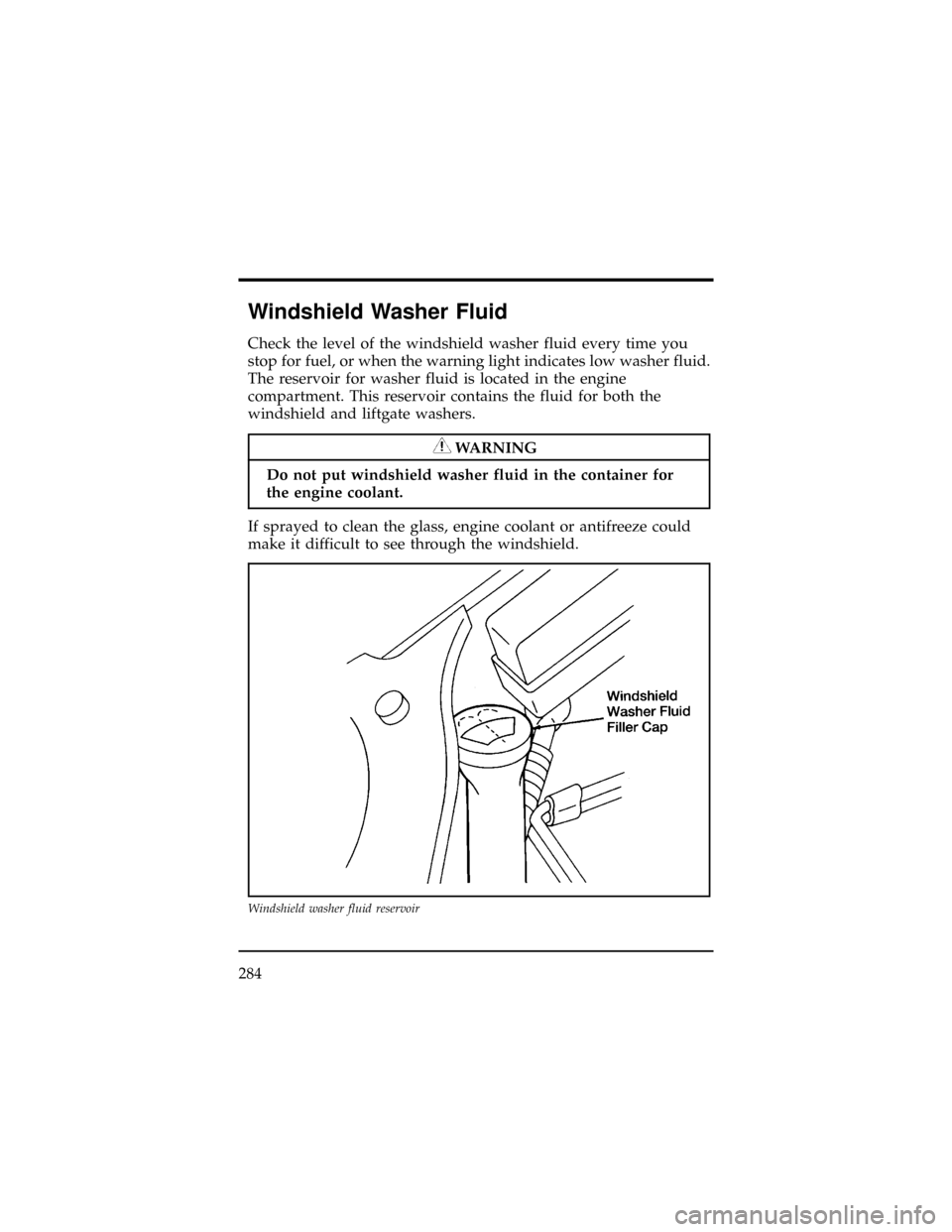engine Mercury Villager 1998 s Service Manual
[x] Cancel search | Manufacturer: MERCURY, Model Year: 1998, Model line: Villager, Model: Mercury Villager 1998Pages: 400, PDF Size: 2.06 MB
Page 274 of 400

Connecting the jumper cables
1. Connect one end of the first jumper cable to the positive (+)
terminal of the discharged battery. (You can connect either
jumper cable to the positive (+) terminal, as long as you use the
same cable for both positive terminals.) Most jumper cables
have a red cable and a black cable. The red cable is generally
used for the positive terminals and the black for the
negative cable of the booster battery and ground on the engine
of the disabled vehicle.
2. Connect the other end of the first cable to the positive (+)
terminal of the booster battery.
3. Connect one end of the second cable to the negative (±)
terminal of the booster battery Ð NOT to the discharged battery.
4. Connect the other end of the second cable to a good metallic
surface on the engine or frame of the disabled vehicle.
WARNING
Do not connect the end of the second cable to the negative
(±) terminal of the battery to be jumped. A spark may
cause an explosion of the gases that surround the battery.
270
Page 276 of 400

Jump-Starting
1. Make sure that the jumper cables are not in the way of
moving engine parts, then start the booster vehicle. Run the
engine at a moderate speed.
2. Let the discharged battery charge for a few minutes and then
start the disabled vehicle. It may take a couple of tries before
the vehicle starts. If the vehicle does not start after several
attempts, there may be a different problem.
3. When both vehicles are running, let them idle for a few
minutes to charge the discharged battery.
Removing jumper cables
1.Always remove the jumper cables in the reverse order.
Remove the negative (±) end of the jumper cable from the
metallic surface on the engine or frame of the disabled
vehicle.
2. Remove the negative (±) cable from the booster battery.
3. Remove the positive (+) cable from the booster battery.
4. Remove the other end of the positive (+) cable from the
discharged battery.
If you need to replace your battery, seeBatteryin theMaintenance
and Carechapter.
Towing Your Vehicle
If you need to have your vehicle towed, contact a professional
towing service or, if you are a member, your roadside assistance
center.
DO NOT TOW YOUR VILLAGER WITH SLINGBELT
EQUIPMENT. Ford Motor Company has not developed or
approved a T-hook sling-type procedure. Use wheel lift or flatbed
equipment.
272
Page 279 of 400

Service Made Easy
Ford has two goals for servicing your vehicle.
1. When we can, we design parts that do not need to be
serviced.
2. We want to make servicing your vehicle as easy as possible.
To help you:
mWe highlight do-it-yourself items in yellow in your engine
compartment so that you can find them easily.
mWhen possible, we design parts that can be replaced without
tools.
mWe give you a Maintenance Schedule that makes tracking
routine service for your vehicle easy. TheMaintenance
Schedulebooklet is part of your owners portfolio.
This chapter tells you about the basic parts that you need to
check and service regularly.
If your vehicle needs professional servicing, your dealership can
provide the parts and service required. Check yourWarranty Guide
to find out which parts and services are covered. Also see the
Customer Assistancechapter of this Owner's Manual.
Ford Motor Company recommends that the Owner Maintenance
Checks listed in theMaintenance Schedulebooklet be
performed for the proper operation of your vehicle. In addition
to the conditions listed in the Owner Maintenance Checklist, be
alert for any unusual noise, vibration, or other indication that
your vehicle may need service. If you do notice something unusual,
see that your vehicle is serviced promptly.
Use only recommended fuels, lubricants, fluids, and service parts
that meet Ford Motor Company specifications. Motorcraft
parts are designed and built to provide the best performance in
your vehicle.
Maintenance and Care
275
Page 280 of 400

NOTE: Always dispose of used automotive fluids in a
responsible manner. Follow your community's
standards for disposing of these types of fluids. Call
your local recycling center to find out about recycling
automotive fluids.
Precautions When Servicing Your Vehicle
Be especially careful when inspecting or servicing your vehicle.
Here are some general precautions for your safety:
mYour vehicle is equipped with an automatic cooling fan. It
may come on at any time without warning. To avoid
injury, always disconnect the negative (-) terminal of the
battery before working near the fan.
mDo not work on a vehicle in an enclosed space with the
engine running, unless you are sure you have enough
ventilation.
mNever get under a vehicle while it is supported only by a jack.
If you must work under a vehicle, use safety stands.
mKeep all lit cigarettes and other smoking materials away from
the battery and all fuel-related parts.
If you plan to work under the hood while the engine is off:
WARNING
Always set the parking brake fully and make sure the
gearshift is latched in P (Park). Turn off the ignition
whenever you leave your vehicle.
WARNING
Always remove the key from the ignition after you turn
off the engine.
276
Page 281 of 400

If you must work under the hood while the engine is running:
mSet the parking brake fully and make sure that the gearshift
is securely latched in P (Park). This will prevent your
vehicle from moving unexpectedly.
WARNING
Do not start your engine with the air cleaner removed and
do not remove it while the engine is running.
mAvoid wearing loose clothing or jewelry that could get caught
in moving parts. Take appropriate precautions with long hair.
Opening the Hood
1. Pull the hood release handle, located below the fuse panel
door.
Hood release handle location
Maintenance and Care
277
Page 283 of 400

To close the hood:
1. Remove the prop rod from the slotted hole in the hood. Place
the rod in its retaining clip and close the hood with enough
force to make it latch. Be sure to oil the hood latch every six
months to maintain smooth operation.
2. Try to lift the hood after closing it to be sure it is securely
latched.
Engine Oil Recommendations
Ford oil specification is WSS-M2C153-G.
Use SAE 5W-30 motor oil certified for gasoline engines by the
American Petroleum Institute.
Do not use supplemental engine oil additives, oil treatments or
engine treatments. They are unnecessary and could, under certain
conditions, lead to engine damage which is not covered by
your warranty.
Maintenance and Care
279
Page 284 of 400

Checking Engine Oil
Check the engine oil each time you fuel your vehicle.
1. Make sure the vehicle is on level ground.
2. Turn the engine off and wait a few minutes for the oil to drain
into the oil pan.
3. Set the parking brake and ensure the gearshift is securely
latched in Park,9P9.
4. Open the hood. Protect yourself from engine heat.
5. Locate and carefully remove the engine oil level indicator (dip
stick).
6. Wipe the indicator clean. Insert the indicator fully, then
remove it again.
mIf the oil level isbetween the L and H marks,the oil level is
acceptable.DO NOT ADD OIL
mIf the level is below the L mark, add enough oil to raise the
level within the L-H range
WARNING
Oil level above the H mark may cause engine damage.
Some oil must be removed from the engine by a service
technician.
7. Put the indicator back in and ensure it is fully seated.
280
Page 285 of 400

Changing the Engine Oil and the Oil Filter
Refer to theMaintenance Schedulebooklet for additional
information.
Follow these directions to change the engine oil and oil filter:
1. Turn the engine off after it has warmed up.
2. Protect yourself from engine heat and the engine oil being
drained.
3. Remove the oil pan drain plug(s)andoil filter.
4. Drain the oil into a container until flow from the drain plug
hole(s) and the filter mounting area slows to a drip.
5. Install the drain plug(s) and a new engine oil filter according
to directions on the package.
NOTE: SeeRefill Capacities, Motorcraft Parts and Lubrication
Specificationsin theCapacities and Specificationschapter
for the appropriate oil filter and engine oil refill quantity.
6. Remove the engine oil dipstick (highlighted in yellow) to
prevent oil contamination of the engine ventilating system while
refilling.
Engine oil dipstick
Maintenance and Care
281
Page 286 of 400

7. Refill the engine with a CERTIFIED engine oil of the preferred
viscosity. Start the engine and check for leaks. Follow
directions inChecking and adding engine oilto be sure the
engine is filled to the proper level.
WARNING
Continuous contact with USED motor oil has caused
cancer in laboratory mice.
Protect your skin by washing with soap and water.
Brake Fluid
Your vehicle is equipped with a brake fluid level indicator in the
master cylinder which lights the BRAKE warning light on the
instrument panel when the brake fluid level is low.
Under normal circumstances, your vehicle should not use up
brake fluid rapidly. However, expect the level of the brake fluid
to slowly fall as you put more mileage on your vehicle and
the brake pads wear.
Check the brake fluid at least once a year. You can do this by
looking at the fluid level in the plastic brake fluid reservoir on the
master cylinder. The fluid level should be at or near the MAX
mark.
WARNING
Brake fluid is toxic.
If brake fluid contacts eyes, flush eyes with running water for 15
minutes. Get medical attention if irritation persists. If taken
internally, drink water and induce vomiting. Get medical attention
immediately.
282
Page 288 of 400

Windshield Washer Fluid
Check the level of the windshield washer fluid every time you
stop for fuel, or when the warning light indicates low washer fluid.
The reservoir for washer fluid is located in the engine
compartment. This reservoir contains the fluid for both the
windshield and liftgate washers.
WARNING
Do not put windshield washer fluid in the container for
the engine coolant.
If sprayed to clean the glass, engine coolant or antifreeze could
make it difficult to see through the windshield.
Windshield washer fluid reservoir
284